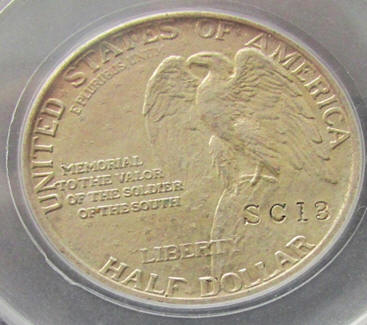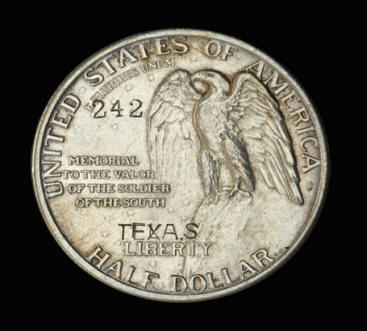The Books with the
Black Cover
“UNLOCKING
THE MYSTERY OF THE COUNTERSTAMPED STONE MOUNTAIN CONFEDERATE MEMORIAL HALF
DOLLAR”
More than you ever wanted to know and yet not enough
By Charles B. Rogers
The time has come that the Stone Mountain Numismatist has long awaited.
The
Stone Mountain Counterstamped Coin Book above contain 1,600 pages in
Volumes I and
Volume II with 800 pages each, totaling 60 Chapters. This
two-volume book written in 2019 is to help unlock the mystery of the
“Counterstamped”
Coin marketing uses— deciphering their incused die stamps codes,
estimating the potential “Counterstamped Coin” population, estimating the
actual number of coins die stamped and give some idea of the total
authorized SMCMA Counterstamped Stone Mountain Coins that exist today.
This two-volume
set is by far the most ever published on these rare Counterstamped Coins
in just short of 100 years.
The Stone Mountain
Memorial Half Dollar is a Commemorative Coin minted by the U.S. Mint as
legal tender in 1925 and is of the standard weight and fineness of their
regular-issued silver counterparts. There were four Coin Campaigns or
Movements from June 3, 1925, to March 31, 1928, to market the
2,313,484 Stone Mountain Memorial Half
Dollar coins received from the U.S. Mint by the
Stone
Mountain
Confederate Monumental
Association (SMCMA) or its agent the
Federal Reserve Banking system in the first few months of 1925 that
distributed them to about 4,000 community banks before the regular issued
coin’s national release date of July 3, 1925.
The Four Coin Campaigns to sell the Stone Mountain regular issued Half
Dollar took place from June 3, 1925, thru March 31, 1928.
1st
Coin Movement, “Preliminary/First Campaign”: June 3-July 3 extended thru
July 31, 1925
2nd
Coin Movement, “Harvest Campaign”: July 20, 1925-January 23, 1926/May 1,
1926
3rd
Coin Movement, “Last Call Campaign”: February 15, 1926-April 15, 1926+-
4th
Coin Movement, “Extension Campaign”: From July 1, 1926, thru June 30, 1927
extended thru March 31, 1928.
There were several methods used to raise funds
to emblazon into Stone Mountain a giant Memorial granite carving to “honor
the valor of the soldier of the south” of the Civil War.
Selling the Stone
Mountain Coin to the public is the most well-known fundraising method. The
“Counterstamped” Stone Mountain Memorial Coin is a marketing tool used in
several ways to help sell the regular issued Stone Mountain Memorial Half
Dollar. The “Counterstamped” Stone Mountain Coin is a regular issued Stone
Mountain Memorial Half Dollar punched with a metal die at specific and
various locations on the reverse at a 1925 cost of $.03 to $.04 cents per
coin to have initials and/or numbers stamped on it as well as the State
abbreviation the coin represents. These die stamps were not punched at or
by the U.S. Mint but was incused by others at the request of the SMCMA or
its representatives. Five of the six major Categories of the 1925
“Counterstamped” Stone Mountain Half Dollar Coins are incused and all six
were used to market the regular issued non-counterstamped Commemorative
Half Dollar. The net proceeds from the regular issued Stone Mountain Half
Dollar purchase price of $1 from the SMCMA were used to help emblazon
Stone Mountain with the giant Memorial granite carving. In the end it is
believed there was not a community in the Southern States so remotely
located as not to be aware of the regular issued Stone Mountain Coin or
the “Monument to the Valor of the Soldier of the South” because of the
publicity produced by the “Counterstamped” Coin.
As previously stated, there were four Campaigns to sell the regular issued
Stone Mountain Coins with the help of six major categories of
"Counterstamped Coins" as marketing tools containing several varieties and
different types of these rare, incused coins. The book contains numerous
"Counterstamped" Coin images and their deciphered uses from all four Coin
Campaigns. There are new and exciting discoveries hidden for just short of
100 years! Discover what these coins were all about while learning a short
history of the regular issue Stone Mountain Coin, the giant granite
Mountain Monument and the people that tried to make it happen.
After years of research finally the book is in print. There are
1,600+-pages in two volumes of images and information on the elusive Stone
Mountain “Counterstamped” Coin that 99.9% of Collectors have never seen or
knew existed. You just think you know the purpose of the Stone Mountain
“Counterstamped” Coin. Find out its multiple uses. Find out more than you
ever wanted to know. Read about the mysteries of the numbers on the coins,
which Southern States had these Coins, deciphering the Code on the Coins,
the potential population of “Counterstamped” Coins for each State, the
potential population of each Category of “Counterstamped” Coin issued, the
Prototype/Test State Auction Coins and Territorial Award Coins, the 100
Series, the First 99 Series and the “600 Series, the latter also known as
the National Auction and Award Coins all of the Preliminary/First/Campaign
as well as the State Auction and Award, Club, Dedicated, and Contest Coins
of the Harvest Campaign or Second Movement. There is also a small amount
of information on the Fourth and last Coin Movement known as the Extension
Campaign and the possible/probably “Counterstamped” multicopy Coins that
sold in that Campaign. There is new and exciting information out of hiding
just short of 100 years!
Following are
examples of Auction Coins. First
is an exceedingly rare County Auction
Coin of
South Carolina (S.C.
No. 13 of 46) and a
Unit or
Town/City Auction Coin of Texas. Texas is the only State over stamped Coin
used as Counterstamped Coins. Many of the existing Texas coins were
surplused coins not used in Florida and Virginia and over stamped with one
of the TEXAS abbreviations. These are followed by a rare Society Lavalier
(Mount Removed) or Society Contest Coin of the District of Columbia (D.C.)
and a, U.D.C. or United
Daughters of the
Confederacy Coin called a Dedicated Coin
in the Fourth or Extension Campaign and called a Club Coin in the Harvest
Campaign or Second Coin Movement.
Category 1: State Serial Numbered Auction Coins
1st Series
SC No. 1-46 (County)
State Serial Numbered County Auction Coin
Coin Category 1, Variety 1
SC No. 1-46 (County Auction Coins)
First Series of Two Series: South Carolina SC
No. 1-100

State
Abbreviation:
S.C.
Serial Number:
13, Lancaster, County, S.C.
Common Name:
County “Auction Coin” (SC No.1-46)
Die Stamp Location:
#4 of 8
Die Stamp Lettering and Styling:
Post Preliminary/First Campaign
[Made after July 3, 1925 (after the original scheduled end of the
1st Campaign) and
before July 20, 1925 (the Southern Governor’s Conference)]
Issued:
July 27, 1925, in Columbia, S.C. at SMCMA State Headquarters with Mr. A.W.
McKeand present with the news media.
This was during the four-week (July 27, 1925-August 21, 1925) selling
portion of the McKeand Campaign, July 6, 1925-August 21, 1925 the earliest
part of the Harvest Campaign. The SMCMA McKeand Campaign
reorganized the State of S.C. while selling an estimated 80,000 Coins
and returned an organized campaign to the State of South Carolina merging
it with the State Harvest Campaign where they sold an additional 70,000
Coins. South Carolina only sold 2,848 Coins in the
Preliminary/First Campaign.
 Texas Die Stamp #2 Variation B - Image by
American Numismatic Association Money Museum
Texas Die Stamp #2 Variation B - Image by
American Numismatic Association Money Museum
Highest
Numbered Texas Auction Coin known after 95 years.
The Texas No. 242 Shamrock, Texas Unit Auction Coin was the FLA. No. 4 - Key West, Florida Unit Auction Coin surplused to TEXAS because the formally did not participate in the Campaigns. They only sold 25 regular issued Stone Mountain regular issued coins of their quota. At that time they were the fourth largest populated Community in Florida. Their Unit Auction Coin became:
FLA. NO. 4
add: T &
S
2_2 =
TFLA.S
2
2
over FLA. _4_
add:
EX over FL =
TEXA.S 242 over FLA. _4_
TEXAS/FLA. No. 242
TEXAS 2_2
over FLA. No. _4_
TEXAS Serial Numbered Unit Auction Coins No. 1-250 (estimated)
Texas had 962 potential Units on the Accountants Alphabetical List that
would yield that many potential Unit Auction Coins, but I estimate there
were only about 250 Units or Town/Cities utilized in the Texas Harvest
Campaign, the Second Coin Movement. A Unit is a Town/City with at least
one Bank.

D.C. No. 1 G.L.- 13 G.L., Type 1
D.C. No. 1 S.L.- 13 S.L., Type
D.C. No. 2 G.L. - Gold Lavalier or Contest Coin
Mount Removed
Coin of the Harvest (2nd) Campaign
Die Stamp Location # 5 of 8
D.C. No. 2 G.L. of 13 Southern State Societies

Die Stamp Location #8
State: N.C.
In the Field of Stars
No.: 859
On Rock Under U.D.C
Club Coin: U.D.C
On Rock over Number
Dedicated Coin: U.D.C. Coins
Dedicated U.D.C. Coin in a Gold Mount of the Extension or 4th Campaign. A similar U.D.C. Coin called a Club Coin was utilized in the Harvest Campaign or 2nd Coin and the Last Call or 3rd Coin Movement but in North Carolina the abbreviation for the State was N. Car. I surmise, the State abbreviations distinguish between the two Campaigns for the U.D.C. Coins of North Carolina. This difference in abbreviations has not been found yet in the three other States (TENN., VA. and ALA.) that are known to have U.D.C. Coins in the Harvest or 2nd and Last Call or 3rd Coin Movement.
U.D.C. Variation B of Die Stamp 8
In the Extension Campaign the U.D.C. Coin was
always in a gold Lavalier where it was another $5 option in the Harvest/
Last Call Era in addition to the $5 for the incused Coin. Note the change
in the State abbreviation from N. Car. to N.C. that I surmise also was
changed for this 4th Coin Campaign.